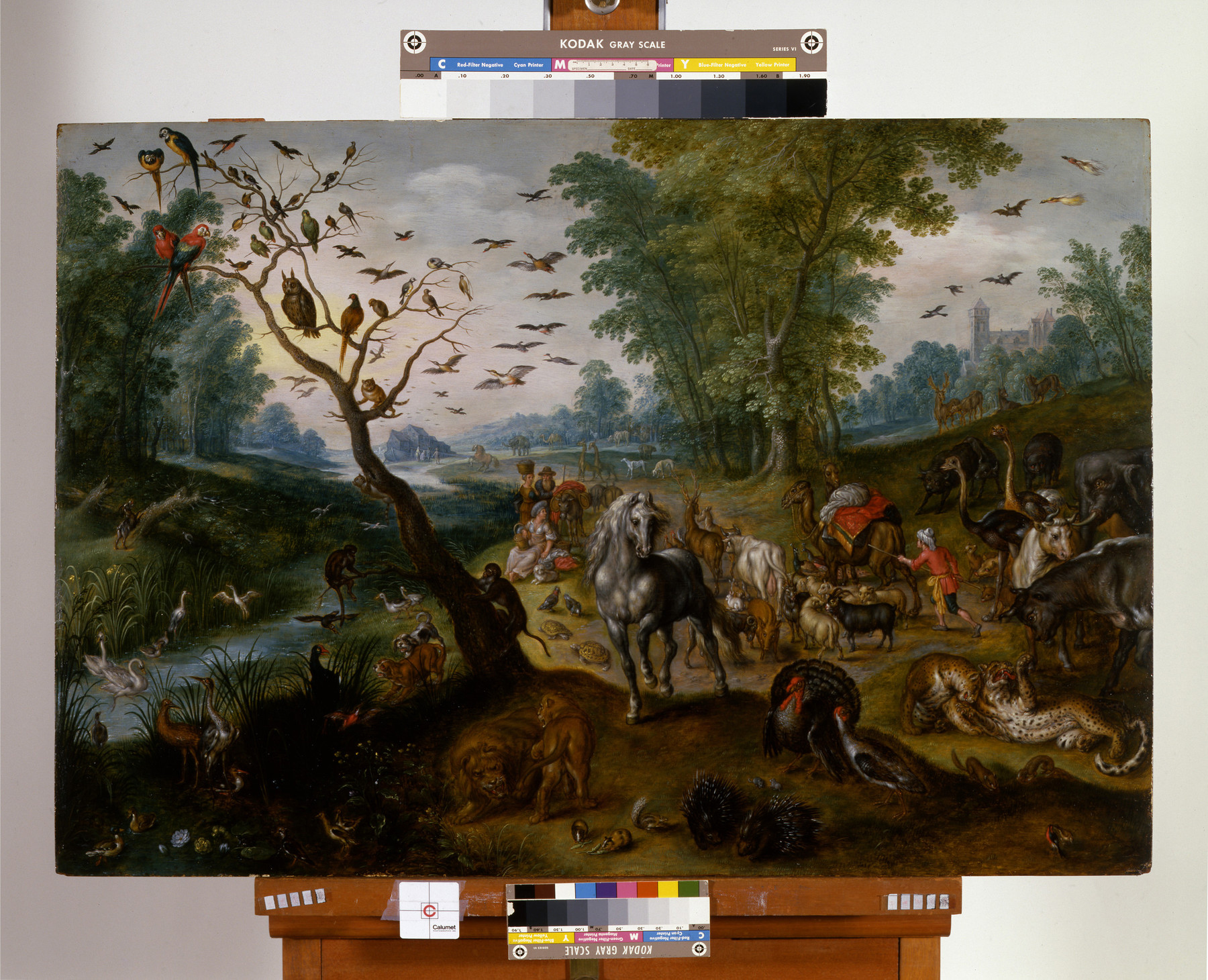Noah's Family Assembling Animals before the Ark
(Baroque Europe )
This gathering of animals would resonate on different levels for a 17th-century viewer in the Spanish (Southern) Netherlands. It is not only the biblical story of the animals gathered by Noah’s family to take on the ark in the distance but reflects both the amazing variety of nature and man’s dominion over nature, qualities fundamental to the collection of natural history specimens and and their display in collections of art and wonders. The majority of the animals depicted were considered exotic by 17th-century Europeans: for example, parrots, the rare purple gallinule, and turkeys from the New World, African ostriches and also African porcupines with their incredibly long quills raised in defense, as well as lions and leopards. The painting could be enjoyed like a visit to the menagerie kept by the archdukes at the court in Brussels, surely the source for these animals. The handsome dapple-gray horse at the center is a Spanish breed imported by Archduke Albert.
The present painting is a descendant of a painting from 1613 by Jan Brueghel the Elder (J. Paul Getty Museum, Los Angeles). The popular composition was produced again in his workshop and also painted by his son Jan Brueghel the Younger. Here, the groupings of animals are distinct, encouraging viewers to study them separately. This is characteristic of animal paintings by Jan van Kessel, nephew of Jan Brueghel the Younger. Van Kessel also developed his own distinctive approach to picturing animals and suggesting their wider representative significance, as in his paintings of the Four Parts of the World (Munich).
A similar version was sold by Sotheby's Monaco 29. XI. 1986, lot 330 (on canvas, 61 x 91 cm), signed and dated 1659; Another version was with in the London trade in 1994. The attribution of the Walters' panel was made by J. Spicer.
Provenance
Provenance (from the French provenir, 'to come from/forth') is the chronology of the ownership, custody, or location of a historical object.
Samuel Borchard, New York [date and mode of acquisition unknown]; Stewart Borchard, New York [Samuel's son]; Kleinberger Galleires, New York [date and mode of acquisition unknown]; Museum of Rhode Island School of Design, Providence; E.& A. Silberman Galleries, NY, 1946; Walters Art Museum, 1946, by purchase.
Exhibitions
| 2012 | Public Property. |
| 2002-2004 | A Magnificent Age: Masterpieces from the Walters Art Museum, Baltimore. The Walters Art Museum, Baltimore; The Nelson-Atkins Museum of Art, Kansas City; Mint Museum of Art, Charlotte. |
| 1998-2001 | Highlights from the Collection. The Walters Art Gallery, Baltimore. |
| 1993 | A Renaissance Puzzle: Heemskerck's Abduction of Helen. The Walters Art Gallery, Baltimore. |
| 1980 | Salute to Belgium. The Walters Art Gallery, Baltimore. |
| 1971-1972 | World of Wonder. The Walters Art Gallery, Baltimore. |
Conservation
| Date | Description | Narrative |
|---|---|---|
| 4/9/1984 | Treatment | other |
Geographies
Belgium, Antwerp (Place of Origin)
Measurements
H: 25 3/4 x W: 37 3/16 in. (65.4 x 94.5 cm); Framed H: 32 3/4 x W: 44 1/4 in. (83.19 x 112.4 cm)
Credit Line
Museum purchase, 1946
Location in Museum
Not on view
Accession Number
In libraries, galleries, museums, and archives, an accession number is a unique identifier assigned to each object in the collection.
In libraries, galleries, museums, and archives, an accession number is a unique identifier assigned to each object in the collection.
37.1998




